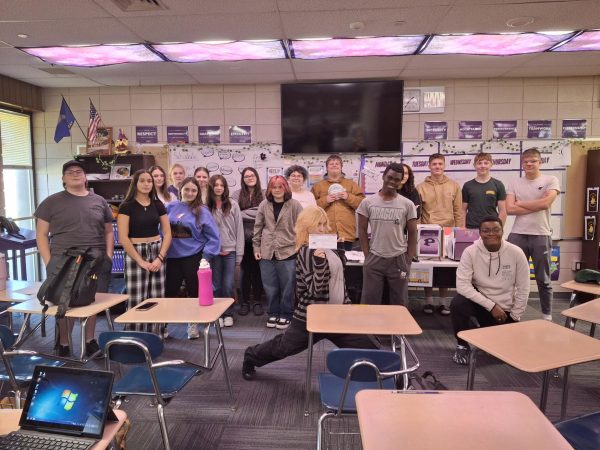As easy as 1, 2, 3
PCMS grading affects incoming freshmen
Freshmen brushed up on their ABCs this year as they reverted back to a traditional letter-based grading system following a year of standards-based grading at Pittsburg Community Middle School (PCMS).
Standards-based grading (SBG) is an alternative approach to academic reporting. Rather than letters, grades are assigned based on numbers.
“A Level 1 is basic, simple material,” PCMS principal Terry Smith said. “Level 2 is a conceptual understanding, but at a minimal level. Level 3 is mastery and Level 4 is extended mastery, [so] you understand why something works and how it works.”
Piloted in the 2015-16 school year, SBG was first implemented as a behavior rubric to measure soft skills such as staying on task and meeting deadlines.
Last year, PCMS saw a building-wide remodel of its grading system to incorporate SBG for academic and behavioral performance.
“All teachers have standards. Then, they have learning objectives or targets, skills that are kind of like substandards,” Smith said. “They have to create assessments, whether it’s formative or summative, and they have to write questions that are leveled. That’s how we grade.”
Smith encountered standards-based grading at his previous job as principal of Parsons Middle School (PMS).
“I had done it at [Parsons], so I had some background with it,” Smith said. “SBG actually ended when I was still there. My opinion is that it was too drastic in terms of change at the time and I wasn’t prepared to address the critics.”
Lori Ray, current principal of PMS, described how SBG is now used only at the elementary level.
“It’s a part of the culture of the district in the primary grades,” Ray said. “When I started teaching in Parsons in the late 90’s, we were using a standards-based grade card. The system in K-2 looks the same today. It’s a Plus for mastery, P for progress, N for not yet mastered or a blank for not yet taught or assessed. It doesn’t have a letter equivalency.”
Now in its third year of implementation, PCMS altered its grading system for the 2017-18 school year based on feedback.
“Because of the concerns that we had addressed from parents and the board last year, we’ve gone to a hybrid,” Smith said. “We are still measuring and using data to drive the curriculum, but there are letter grades assigned to it.”
Numbers are used to calculate a letter equivalent for the overall grade. An F is 0-1.4, D is 1.5-1.9, C is 2.0 to 2.6, B is 2.7-3.3 and an A is 3.4-4.0.
PCMS section leaders are responsible for creating rubrics for each standard across each department for each unit.
“With SBG, I feel like I know my kids’ strengths and weaknesses more than I ever have before,” PCMS math teacher Adam Hull said. “I feel like it’s more individualized, I know what they can and can’t do, and I can narrow down instruction for those kids who need that extra guidance. More importantly, [we are] taking those kids who do [understand] deeper into the standard.”
“We didn’t invent standards-based grading, it’s been around for a while,” Smith said. “This started [during] my first year here. I took our leadership team, a group of 10 or 12 teachers, to a national conference in Colorado. At that conference, our teachers had an epiphany that we could be grading more effectively, more accurately, more fairly by using this method. Some teachers who went to that breakout session came to me and said, ‘Hey, we want to try this.’ That’s how it started, and then we started educating ourselves. We visited some other school districts that were doing standards-based grading in our area. We did some research into how it works and it has evolved into what it is today.”
PowerSchool averages the final grade a student receives on each academic and behavioral standards throughout.
“What’s in the gradebook is the current level of understanding for every standard, so it’s not averaged,” Smith said. “At the beginning of a unit, [a student] probably didn’t have very good scores. By the end of it, they may have a Level 4 understanding, so we’re not going to punish them by averaging that with what they had in the beginning. We’re going to report what it is now.”
To differentiate academic grades from soft skills, PCMS still utilizes the behavior rubric.
“There’s another thing that distorts letter grades,” Smith said. “If you turn something in late, points are taken off. Grammar errors on a writing paper knock an A paper down to a B. We want to report the quality of the work. But the soft skills — turning things in on time, putting forth effort — we measure that separately. If you did a book report that was quality material, but you turned it in late and got a lower grade, we want to report [that] they’re turning things in late, so we’re reporting them separately.”
The implementation of SBG has received mixed reactions.
Freshman Christopher Saman saw a positive impact grasping concepts, but was not sure if he was prepared for the next level.
“The teachers knew exactly what to help test you on so you can become better. That was the nice thing about it,” Saman said. “It wasn’t too difficult, but I don’t think it was greatly preparing us for high school and how we can shoot for [better] grades. The number-based grading isn’t going to transfer onto our [transcripts], so it’s not really going to benefit us much.”
For some students, changing the grading policy may have done more harm than good.
Freshman Blake Harrison said that while the policies may have been effective, they set him back.
“It was easier at the middle school because you got to make up a lot of work and it wasn’t like if you messed up, you were screwed. You could come in whenever you wanted to retake,” Harrison said. “Now, if you mess up at the high school, it’s your final grade. I think most kids have struggled with that because we’re just not used to having a deadline and meeting it.”
In a letter sent in for public comment at a board meeting last summer, Rebecca Light, mother of freshman Ethan Light, noted the consequences of SBG may have been overlooked.
“Setting the expectation in a student’s mind that you get to keep working on a subject over and over until you master it with no accountability for deadlines is setting a student up for failure as they enter the work world,” Light said. “As an employer, I expect my staff to master skills quickly and in a standard timeframe.”
PHS social science teacher Gary Wolgamott has noticed a difference in the freshman class.
“It is important to remember that every incoming freshmen class has its own strengths and weaknesses, and we have to be careful not to compare classes,” Wolgamott said. “Having addressed that, more students seem to struggle with due dates and time management in general than in the past, which many students feel is attributed to the grading system.”
However, PHS English teacher Linda Barberich has seen an improvement in the freshman class.
“My observation would be based on the first semester, but I felt this year’s incoming freshmen were well-prepared,” Barberich said. “Students have been on task and are comprehending the concepts well. Overall, they have been good about meeting deadlines.”
Wolgamott shared his students’ viewpoints discussed in class.
“My freshman students have voiced some comments in class about the system and the general consensus is that it does not prepare them for the transition to high school,” Wolgamott said. “Many have commented that too much emphasis is placed on test scores and not on the other elements of classroom work which they feel enhances their learning, especially those who suffer from test anxiety.”
Workload has been another area of contention for SBG implementation.
“[The transition] was difficult because we didn’t have any homework during [standards-based grading],” Harrison said. “But now that we have homework and we have to do it, it’s a lot tougher.”
As outlined by the PCMS student handbook, homework is assigned per grade level.
“Research suggests that an effective homework practice is no more than 10 minutes
multiplied by the grade level,” the handbook said. “For example, sixth-grade students should have no more than 60 minutes of homework a night. This is per grade level, not per class. Therefore, parents should expect PCMS students to have about one hour of homework on any given night.”
In a study conducted at Northeastern University in November 2011, researcher Theresa Craig examined 103 elementary schools in Massachusetts to determine the correlation between grading system and student performance.
“The terminology used in report card performance levels should be consistent, recognizable and easily understood, but the labels or letters used as representation of those levels may be irrelevant,” the report said. “The growth and performance of students in schools using standards-based report cards was not significantly different from students in schools [not] using standards-based report cards.”
Another research paper by Kate Sugarman in July 2015 asserted that teacher training was pivotal to the system’s success.
“Because standards-based grading is a relatively new innovation, none of the teachers experienced such a system when they themselves were students in school. Because teacher expectations are heavily shaped by their own experiences as students, it has been difficult for some teachers to understand and implement standards-based grading. In addition, implementing standards-based grading takes a considerable amount of technical expertise.”
Currently, expansion of SBG to the district elementary schools or high school is not under immediate consideration.
On Tuesday, district elementary principals met to discuss SBG reform. According to an email received later that evening, “Transition to an SBG model is not necessary at this time since we utilize standards-based instruction practices.”
Principal Phil Bressler does not envision adopting SBG at this time.
“Our freshmen are the first group, so we don’t have enough of a track record,” Bressler said. “I think we’ve got to have [SBG at PCMS] a little bit longer before we know whether or not it’s a positive or negative there, let alone how it affects them here.”
Another factor under consideration is the preparation for life after high school.
“The problem with high schools [switching to SBG] is so much of what we do is tied to the next step in life. It’d be hard to get away from letter grades at the high school because of that long-standing tradition of giving letter grades in colleges. It would be a huge undertaking at this level to make that happen. It’s feasible, but we would be a long ways from that. PHS is not ready for standards-based grading today.”
For the counseling department, the high school enrollment process had to adapt without transcript data.
“We don’t even see the numbers,” counselor Jessica Stegman said. “The teachers did a lot of the work for us. The high school staff communicated with the middle school staff regarding [students’] work habits in class, their MAP data, how [far] they got in their curriculum and a lot of back and forth.”
Currently, the counseling department relies heavily on teacher recommendation to determine remedial, regular or an advanced placement, a practice that is expected to continue.
“They gave us a list of kids who were recommended for the upper-level classes and the honors courses,” Stegman said. “We talked to the middle school counseling staff, making sure we had them in the right classes. It takes us a little longer, but right now that’s going to be the process.”
When requested, no comparative MAP data was received from PCMS. Two PCMS teachers, seven sets of parents of district students and one area principal declined to comment.
Your donation will support the student journalists of Pittsburg High School - KS. Your contribution will allow us to purchase equipment and cover our annual website hosting costs.






